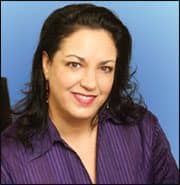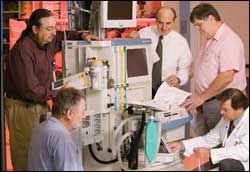 |
| Left to right, Curtis A. Blair, research nurse; John Klasen, manager; Yadin David, director, biomedical engineering; Ronald Robb, manager; and John Weimert, assistant director. |
Many biomedical engineering programs work to stay at the center of it all, maintaining a high profile within their health care organizations. For the team of 62 people—including approximately 45 technicians—at Texas Children’s Hospital in Houston, that goal has been accomplished. Literally.
“We are directly above administration, just an elevator ride away; we are a stairwell above nursing administration, and we are in the crossroads between several patient care areas,” says Yadin David, EdD, CCE, PE, director of biomedical engineering and the center for telehealth. Because of this, the hospital’s clinicians—physicians, nurses, respiratory therapists, as well as administrators—are constantly filtering through the biomedical department.
“Therefore, they not only become more aware of the program, but we have an opportunity for short visits and small talk that make sure we are always in line with what is going on,” David says. “It also keeps them up to date with what we are achieving. It’s just a very advantageous space to have.”
Benefits of residing in the hospital’s hub also work in reverse. “One of the things we take pride in is our response time to clients when they have an issue,” says Ron Robb, manager, biomedical engineering and TV services. “As big as the campus is, it’s really important for us to be centrally located and have easy access to numerous pathways around the place. Where we are now, we have two to three different potential routes to any one area, and we’re usually standing at the bedside—or wherever it is they called us from—in less than 10 minutes.”
The department’s valuable real estate was claimed by the biomeds after their previous space—about 23,000 square feet in the hospital’s basement—was flooded in 2001. Water destroyed millions of dollars worth of medical and test equipment, along with all of the shop’s tools.
“It was devastating, because for our department, it was a total loss,” says John P. Weimert, assistant director of biomedical engineering, who has been with Texas Children’s for more than 3 decades. As reconstruction started on the building, the team was given several different locations to choose from, including a facility across the street from the main campus. “That was unacceptable; we did not want to be out of sight and therefore be out of mind. To us, it is very necessary to keep our group close to and amongst the clinical caregivers.”
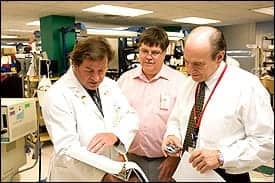 |
| Another area that falls to the biomedical staff at Texas Children’s Hospital is incident investigations. |
Being close to the clinicians is critical to the way Texas Children’s techs do business, not only physically, but philosophically as well. “Because of the way we function in this engineering department, we are tied directly to the point of care,” Weimert says. “We wear the scrubs, we wear the lab coats. When we walk into an area, the clinical caregiver sees us as one of them, as a fellow team member. But if you come from across the street, suddenly you’re an outsider.”
What exists now is a total of 16,000 square feet divided equally between two floors. One level houses the administration, training, education, and incident-investigation offices and labs. The other is dedicated space where the techs can perform tasks related to servicing and maintaining devices.
On the upper story, a large conference room is equipped with full audiovisual equipment, including video-conferencing devices and central gases. This allows techs training on anesthesia machines, for example, to gain real-world experience by having the ability to pipe gas directly into the room.
While separated vertically, David did not want a feeling of separation to distance the functions taking place in different areas. “I didn’t want to send the message that training and education is not for technicians working on service and maintenance, so between the floors we have two banks of elevators and a stairwell. It is unbelievably easy to move between the floors,” he says. “We even have doors that are sensitive to a technician carrying equipment. I wanted to make sure that if you’re carrying something you are not going to drop it or you are not going to bang it against the door, so we installed a mechanism that automatically opens the door when somebody with a biomedical engineering badge approaches.”
A Customized Workspace
Not only was the space allocated specifically for the biomedical team, but the furniture that filled it was customized as well, with input from the techs who would be spending their days using it. All of the bench space areas were designed to meet the specific needs of biomeds. Because they were provided with a blank slate, every aspect of the shop was evaluated in terms of convenience and efficiency. Work areas are laid out to allow the congregation of technicians around specific modalities, so techs can readily consult one another, share equipment, or cover for one another on service calls when necessary. Additionally, the spare parts inventory and the dock that accepts delivery of equipment are in the center of that space, making it rapidly accessible from anywhere in the shop.
Weimert, who led the design effort, even re-examined the functionality of the traditional workbenches. “In the past, we have had technician workbenches that were always casework. They were built in, made of plywood, and covered with a laminate so you had a bench with drawers that was all one piece,” he explains. Eager for something customized, Weimert enlisted the services of a company that produced a bench tailor-made for Texas Children’s Hospital. “We wanted a more adaptable workbench and work surface to support the many different roles that our technicians work in.”
What the company came up with was a workbench with a separate rolling drawer unit sized so it can slide under the bench for easy storage. The top of the drawer unit can also be used as a work surface similar to that on a rolling kitchen island.
“Not only is it a convertible space, but it also gives technicians a rolling tool chest they can take with them if they are working on a project outside of the shop,” Weimert says. “It has really allowed us to give the technicians an additional resource.”
A Broad Reach
Though they tend to about 25,000 devices, worth roughly $120 million, the popular “devices per full-time employee” measurement of efficiency tends to be lower at Texas Children’s than for other biomedical teams.
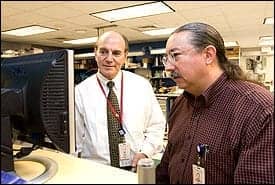 |
“That seems to be one of the popular benchmarks for a biomed department, and we always end up a little low on that list, because we do so many other things that a lot of biomeds don’t do,” says Robb, who has logged 29 years with the organization.
One example is the installation of medical equipment, all of which is done by Texas Children’s Hospital’s biomeds. The hospital does not purchase any of the installation process from vendors. “Right now, we’re replacing all of our central station monitors,” he says. “Installing all of those is a massive undertaking, especially when you consider all of the planning that goes into it and all of the prepurchase evaluations. We also coordinate all of the training.”
Not only does biomedical engineering often arrange for user training on devices, but the AV-enabled conference room has become a valuable resource for training the resident techs, among others. “I decided to open it up to function basically as an original training center,” David says. In addition to hosted vendors teaching Texas Children’s Hospital’s staff, several companies have used the space. “GE brought in their IT training for biomedical engineering that we developed together and was piloted here.”
The room has also been the site of a laser safety officer certification program. “We conducted the preparation class, and then we conducted the certification exam in our space,” David says. “When vendors come in, it’s a very simple proposition. They are welcome to use the space at no cost if I can have people from my department participating. If they permit several of my people to participate, then the vendor is welcome to invite people from other hospitals to participate.”
As a result, the team has gained a wealth of knowledge covering a number of topics that typically fall outside the purview of biomeds. Within the hospital, for example, David’s team has become the department of choice for the development and planning of newly built and remodeled spaces.
“The leader of that group is the senior medical equipment technology architect, and he leads the team that works with both the architects and the clinical end user in developing the space and its requirements,” Weimert says.
Such extensive involvement in planning new clinical areas of operation started when the biomeds were looped into the development of a cardiac catheterization laboratory tailored to the special needs of the hospital’s pediatric patients.
“While many people can do it for adults, very, very few have experience doing it for children, but we do,” David says. “So we worked with the contracted architects and planners to specifically bring our expertise online. In the process, we realized we were doing an excellent job in more than just advising, but actually planning the details, all the way down to where the trash cans should be placed.”
Almost immediately, biomeds took over the function and developed a formal program for equipment planning for any space in the health center, the clinic, or the hospital involving medical technology. The only areas not handled by the biomed team are nonclinical areas.
In addition to the clinical needs of a new area, one of the requirements for all of these spaces is a biomed presence. Carving out the dedicated floor space is rarely a challenge for the team. “We’re part of the planning process, and the customers are so used to having us right there to help them that they don’t want to do without us,” Weimert says. “They are willing to give us the space because they see the value of having us there.”
Digging Deeper
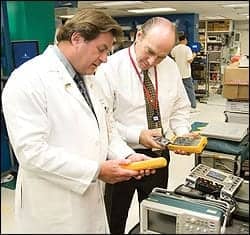 |
Another area that falls to the biomedical staff at Texas Children’s Hospital is incident investigations. Time is dedicated to identifying the cause of the adverse event and working with the clinical staff to prevent reccurrences. Curtis A. Blair’s primary responsibility is this area. Blair is not only a tech, but he’s also a registered nurse (RN). After almost a decade working as an engineer designing rock bits for oil field and mining applications, Blair went back to school to become a nurse. He spent 4 years working in the shock/trauma ICU at a Houston-area hospital and then, in 1994, left to join the biomedical engineering staff at Texas Children’s.
“They were looking for somebody with engineering experience and nursing experience to coordinate medical equipment evaluations,” Blair says. “I always knew that one day I’d be able to find a position that allowed me to use both skill sets, but I wasn’t sure how. This is how.”
Bringing an RN onboard came about because David saw a need to develop a bridge between the technology evaluation process and the clinicians.
“I noticed we were putting engineering reports together that didn’t mean anything to a clinician. The nurse would look at it and after reading it, look at me and ask, ‘So what are you saying? What is the recommendation?’ ” David recalls. “I needed someone to take engineering terms and translate them into words the clinicians would understand.”
As a result, Blair spends much of his time on new technology investigation and evaluation—not just on determining the desirability of the device, but on working with nurses and physicians to ensure they understand why something is accepted or rejected.
“A good example would be simple connectors, such as lead connectors to EKG cables,” Blair says. “I can explain why the locking mechanism is not durable and show where things break.” His nursing background means he can translate this engineering viewpoint into something the clinicians can understand. “For things like that, they’ll tell me, ‘We’re more concerned about the device working.’ I explain that the device is really solid, but if the connector is flimsy and breaks, then the box is useless.”
Just as often, Blair takes time to explain the clinician point of view to techs. An evaluation of infusion pumps provides the perfect example. “Since I’ve been in a nursing unit working as a nurse, I knew right away what some of the pet peeves would be with the equipment,” he says, explaining that while a small infusion pump is perfectly acceptable on a technical level, it can present some functional challenges. “With a little infusion pump, when you push the buttons on the front, the pole will have a tendency to move away. That doesn’t happen with a larger, heavier infusion pump, which will remain stationary when you press the buttons.”
For nurses, one-handed programming is an advantage. “Typically, a nurse is holding something in the other hand,” he says. “It could be a bag of fluid, numerous other things, so having to do something with both hands creates more work for them.” To make sure nurses have their needs addressed, Blair incorporates such grievances into the evaluation forms.
The techs very much appreciate Blair’s unique perspective. “As biomeds, we understand the technology, we understand the physics, we understand the equipment and electromechanical issues,” Weimert says. “Curtis gives us the clinical spin on an incident, so we are able to put the pieces together and come up with an investigation that gets us to the root cause—and that creates a better patient-safe environment.”
The Long Haul
With only 13 years at Texas Children’s, Blair is a relative newcomer. The biomedical engineering group is peopled with professionals who have logged decades of work with the organization.
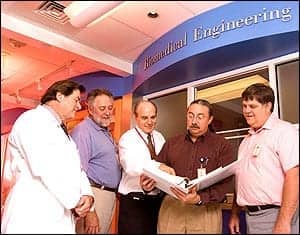 |
Such longevity is no accident. David, who recently celebrated a quarter century with the hospital, is very deliberate in his efforts toward employee retention.
“The big thing for me is continuous excellence, day in and day out: That’s what I expect of myself, and therefore, of everybody else in the program,” David says. “To achieve that, you have to have a high level of knowledge and experience, and you cannot sustain that with a continuously revolving door of people coming and going. Every time you lose individuals, replacing them is not only costly, but it’s delaying having the program at high gear. For me, to be consistently delivering performance that is nothing short of excellent, you have to pay attention to retention.”
Much of this comes from a proactive approach to career development. “At the end of each year, we do a performance evaluation and create a development plan along with that,” Weimert says. “It’s done as a two-way communication, because the technician is the one who actually plans it.” During this meeting, the tech’s performance goals for the upcoming year and new skills to be obtained are reviewed and approved by the manager. “It’s a good process, because it allows us to plan the career development for each person during the course of the next year.”
Robb appreciates the opportunity to be constantly learning and growing in his chosen profession. “When I hired in, I was still in school, at the lowest entry-level job we had at the department,” he says. “I’ve basically worked every job level up the chain since then, so I really have an appreciation for each of the job levels along the way. It helps to understand the big picture and what the techs are up against.”
Dana Hinesly is a contributing writer for 24×7. For more information, contact .





